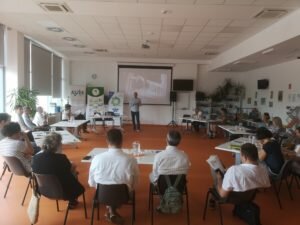Living Labs
2019. június 20-án került sor a második Living Lab rendezvényre Magyarországon a FISSAC projekt keretében „Építési és bontási hulladékok a körforgásos gazdaságban és ipari szimbiózisban” címmel.
A szakmai fórumon mintegy harminc szakember vett részt az FKF Nonprofit Zrt. rákospalotai Szemléletformáló és Újrahasználati Központjában, melynek szervezői a Geonardo Kft. és Környezetvédelmi Szolgáltatók és Gyártók Szövetsége, szakmai támogatói pedig a Magyar Környezettudatos Építés Egyesülete (HuGBC) és a Magyar Cement-, Beton- és Mészipari Szövetség voltak.
A fél napos fórum során előadások hangzottak el az ipari szimbiózishoz kapcsolódó projektekről, illetve az építési és bontási hulladékok újrahasznosításának jelenlegi magyarországi helyzetéről és kihívásairól. Ezt követően a résztvevők megosztották egymással tapasztalataikat e témákban, külön hangsúlyozva azokat a tényezőket, melyek jelenleg akadályozzák vagy megnehezítik a körforgásosság irányába történő elmozdulást. Végezetül a fórum javaslatokat fogalmazott meg az őszre tervezett következő Living Lab témáira és meghívott résztvevőire vonatkozóan.
Építési- és bontási hulladékok a körforgásban és az ipari szimbiózisban
FISSAC Fórum II.
Időpont: 2019. június 20. 9.00 –12.00
Helyszín: Szemléletformáló és Újrahasználati Központ, Budapest XV., Károlyi Sándor u. 166.
- Miért fontos felkészülnie a vállalatoknak a körforgásos gazdaságra?
- Melyek a körforgásosság felé történő elmozdulást jelenleg gátló hazai tényezők?
- Miként nyújthat az ipari szimbiózis megoldást a hazai érintettek, szereplők számára?
- Milyen előnyökkel jár, ha részt vesz Ön is a FISSAC hazai fórum sorozatán? (tovább…)
Circular business models are solid enough only if there is market demand behind, and we all know that users create the demand. Thus, conscious, informed consumers can drive the transition to alternative and circular business models. Some questions arise from this statement:
How would the way we build change if users decided on the design and use of the buildings and public spaces they inhabit?
- How would the professional relationships among the different actors within the construction value chain be transformed if consumers demanded renewable, healthy materials, bioclimatic buildings, modular constructions designed for deconstruction…?
The second FISSAC Living Lab Barcelona, co-organized by SIMBIOSY together with the Societat Orgànica (a professional cooperative that works in the field of sustainable building) on the 30th of October 2018, , served as a visualization spot of successful experiences and as a space for an exchange of views and ideas.
A FISSAC H2024 és a TRIS Interreg Europe projektek keretében a Geonardo Kft. és a Herman Ottó Intézet Nonprofit Kft közösen indított fórumsorozatot. hazai építőipar erőforrás hatékonyságának elérése érdekében. Az első találkozót a CONSTRUMA 2018 kiállításon szervezték meg 2018. április 13-án. (tovább…)
To understand the challenges and opportunities for industrial symbiosis you need to understand your value chain and where value for your sector is created. But just knowing your value chain may not be enough. Following the TIS structure of analysing your Technological Innovation System (TIS) you will be able to identify drivers and barriers for change. You will look at your actors and your value chain, but also at different networks, institutions and how a lack of knowledge and underdeveloped technology may be what is preventing change and hindering the development of industrial symbiosis.
In this new FISSAC report you will find an accessible introduction to the field of TIS and you can find a case study, explaining how the TIS methodology can be used in conjunction with a material journey, following a material from production to destruction and reuse.
We hope that this report and case study will help you in conducting your own analysis and developing your field of industrial symbiosis.
Browse FISSAC Living Labs
Hírek az Interaktív Fórumokról
Living Labs- Második Living Lab budapesten 21 június 2019
- MEGHÍVÓ: II. FISSAC Fórum | 2019. június 20. 7 június 2019
- Second Living Lab in Barcelona: circular business models 8 január 2019
- Erőforrás hatékonyság a hazai építőiparban 12 június 2018
- New report: Technological Innovation System (TIS) analysis 14 május 2018



